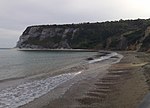SS Empress Queen
1897 shipsFerriesMaritime incidents in 1916Paddle steamersPassenger ships of the Isle of Man ... and 5 more
Ships built on the River ClydeShips of the Isle of Man Steam Packet CompanyUse British English from May 2017World War I ships of the Isle of ManWorld War I shipwrecks in the English Channel

SS Empress Queen was a steel-hulled paddle steamer, the last of her type ordered by the Isle of Man Steam Packet Company. The Admiralty chartered her in 1915 as a troop ship a role in which she saw service until she ran aground off Bembridge, Isle of Wight, England in 1916 and was subsequently abandoned.
Excerpt from the Wikipedia article SS Empress Queen (License: CC BY-SA 3.0, Authors, Images).SS Empress Queen
Geographical coordinates (GPS) Address Nearby Places Show on map
Geographical coordinates (GPS)
| Latitude | Longitude |
|---|---|
| N 50.666666666667 ° | E -1.0833333333333 ° |
Address
The Landslip
PO35 5QW
England, United Kingdom
Open on Google Maps








